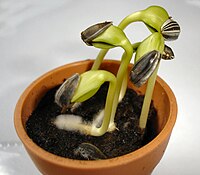
Photo from wikipedia
Despite the widespread distribution of proteorhodopsin (PR)-containing bacteria in the oceans, the use of light-derived energy to promote bacterial growth has only been shown in a few bacterial isolates, and… Click to show full abstract
Despite the widespread distribution of proteorhodopsin (PR)-containing bacteria in the oceans, the use of light-derived energy to promote bacterial growth has only been shown in a few bacterial isolates, and there is a paucity of data describing the metabolic effects of light on environmental photoheterotrophic taxa. Here, we assessed the effects of light on the taxonomic composition, cell integrity and growth responses of microbial communities in monthly incubations between spring and autumn under different environmental conditions. The photoheterotrophs expressing PR in situ were dominated by Pelagibacterales and SAR116 in July and November, while members of Euryarchaeota, Gammaproteobacteria and Bacteroidetes dominated the PR expression in spring. Cell-membrane integrity decreased under dark conditions throughout most of the assessment, with maximal effects in summer, under low-nutrient conditions. A positive effect of light on growth was observed in one incubation (out of nine), coinciding with a declining phytoplankton bloom. Light-enhanced growth was found in Gammaproteobacteria (Alteromonadales) and Bacteroidetes (Polaribacter and Tenacibaculum). Unexpectedly, some Pelagibacterales also exhibited higher growth rates under light conditions. We propose that the energy harvested by PRs helps to maintain cell viability in dominant coastal photoheterotrophic oligotrophs while promoting growth of some widespread taxa benefiting from the decline of phytoplankton blooms. This article is protected by copyright. All rights reserved.
Journal Title: Environmental microbiology
Year Published: 2020
Link to full text (if available)
Share on Social Media: Sign Up to like & get
recommendations!